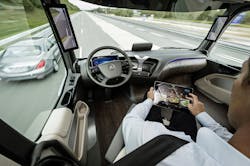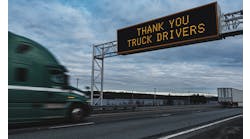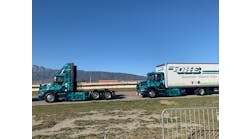In autonomous trucking years, 2014 feels like a lifetime ago. It was in July of that year when Wolfgang Bernhard, then head of Daimler AG’s global trucking business, unveiled the Mercedes-Benz Future Truck 2025.
On a closed off stretch of the Autobahn in Germany, Daimler demonstrated its “Highway Pilot” technology that is the basis for its automated driving system. Bernhard made the prediction the truck would be commercially viable by 2025.
The lasting images of that event are of Bernhard and other truck drivers sitting angled away from the steering wheel and using a tablet while the truck was in motion. Even today, these exact photos are often used to illustrate stories of how truckers are about to lose their jobs to “robot” trucks.
Now may be a good time to stop using them to illustrate autonomous driving. At a media briefing last week, Roger Nielsen, CEO of Daimler Trucks North America, stressed the company’s goal of developing advanced driver-assistance systems, rather than “autonomous” trucks.
Nielsen repeatedly used the word “automated,” rather than “autonomous,” and stated the company’s position that trucks will not become driverless anytime soon. In reality, that actually isn’t far different from 2014, when Highway Pilot was positioned as a way to easy the job of driving, rather than replacing truckers.
After Nielsen made his comments, I asked him about Daimler’s timeline to 2025. As fast as technology advances, Nielsen was quick to point out how much work remains.
“You have to imagine everything that would be required to happen to have a driverless vehicle - and society is not ready for that yet. Honestly, that has to be changed,” he said.
While the public has come to accept human error in highway crashes, they will not be as quick to forgive the company that wrote the software on “how to crash.” Nielsen cited how hard it is to program autonomous driving systems to operate properly at four-way stop signs and crowded intersections.
“To code that and to make the decisions within the braking, steering, and acceleration of the vehicle … is quite a huge task,” Nielsen said.
Research continues to develop vehicles that boost safety and allow drivers to one day “not pay as much attention,” but this was another indication the truck driver is going to remain behind the wheel for many decades to come.




